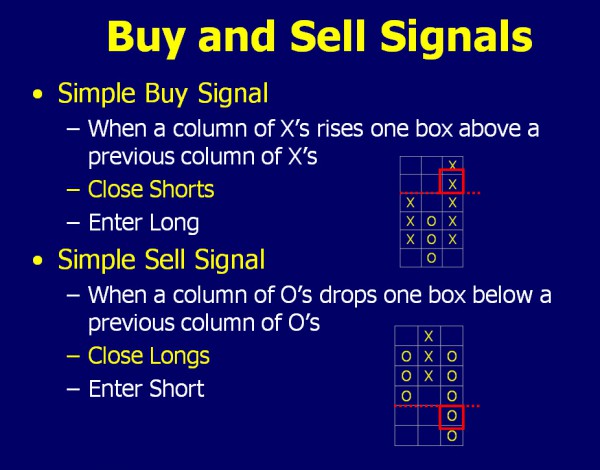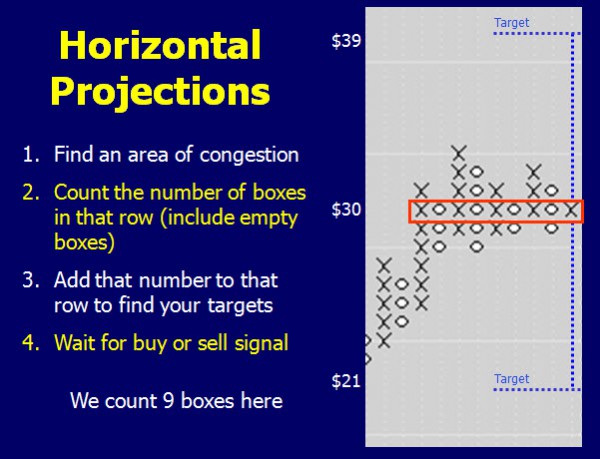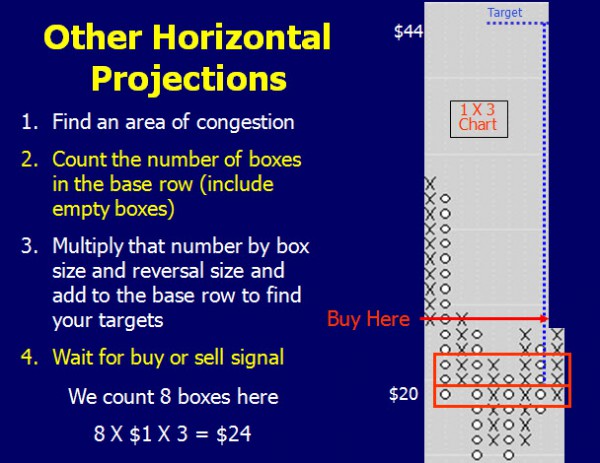Today, many chartists have switched to candlestick charting to make their decisions to buy or sell. A drawback to this style of charting is that many people are prone to exiting early from profitable trades when they see small pullbacks or corrections. An advantage of point and figure charting is that it allows the trader to see the trend and stay in the trend even through minor corrections. For this advantage, we may sacrifice some profits with a larger stop but with the larger profit potential it may be worth it.
Another interesting feature of point and figure charts is that it does not take time into account when charting. On a candlestick chart, you will have a candle for every period. For instance, on a five minute chart, you would have a candle every five minutes whether the price moved or not. In a P&F chart, a new notation is made only when price moves by a certain amount. If there is no trading or if price does not move enough, no notation is made.
To create the chart, you will use an “X” to note when prices rise by a certain amount and an “O” when they decline by an amount. You only put either X’s or O’s in a column. If you need O’s due to a reversal in price, you would start a new column. You do not put X’s and O’s in the same column. You must first decide the minimum amount of movement to note. This is referred to as the box size. You can set the box size for anything you would like but remember the smaller the size, the more sensitive the chart will be. This may be good for short term traders but it can cause you to overreact to slight corrections. As a rule of thumb, you should set the box size at about 1% of price. You could use 2% when charting the indexes like the S&P 500 and the NASDAQ.
You also need to decide the reversal setting. This will be the multiple of the box size that would create a reversal signal. For instance, if you set the box size at $1, a 1×1 chart would change from a column of X’s to a column of O’s when price reversed by $1. On a 1×3 chart, you would continue to mark X’s for the upward movements until you have price reverse by at least $3 ($1×3). Once that happens, you would start a column of O’s to the right of the previous column.

The larger reversal size will filter out many small corrections that might have otherwise scared traders out of positions.
Buy and sell signals can be as simple or as complex as you would like. You can take a simple buy signal when a column of X’s rises above the previous column of X’s. You could stay long until a sell signal has been generated. The simple sell signal comes when a column of O’s breaks below a previous column of O’s.

When we trade, we should know at least three things about the position before we take it. We need to know our entry, the stop, and the target we hope to achieve. A point and figure chart can offer all of that to us. We can place our stops for longs just under the last column of O’s. As long as there is no reversal that breaks that low, we stay in the trade.

The system would be similar for shorts. We would enter a short on a sell signal and place our stop above the previous column of X’s. We would stay in our short position until we have breached that previous high.

If we happen to be long or short in a large move, we may not want to wait for a large reversal to exit. If we were to wait, we may give back too much profit. So instead of waiting for the typical sell signal, stop yourself out when you have the first three box reversal.

For the target price, we can use a horizontal box count. When prices move, they usually originate from a basing area. We can project the width of this basing to offer probable targets for the trend when we are in. The target does not have a timeframe and can take time to reach. Remember, only price movement matters, not the passage of time.

If we are using a larger reversal size, 1×3, 20×3 or so, we can still use a horizontal projection. In this case, we would multiply the horizontal box count by the box size and the reversal size to determine the projection length.

Part 2 concludes next week.
Brandon can be contacted on this link: Brandon Wendell
Last edited by a moderator:
